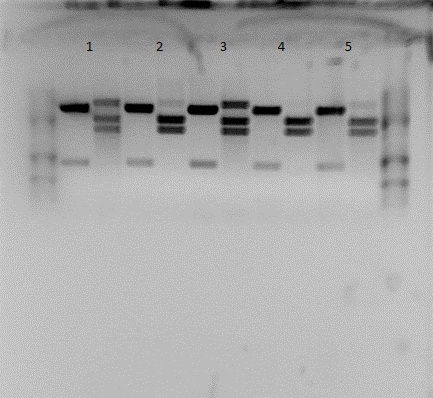Team:NTNU Trondheim/LacI+pLac+mCherry
From 2011.igem.org
m |
(→Stress sensor precursor (LacI+pLac+mCherry)) |
||
| Line 31: | Line 31: | ||
| - | The composite biobrick has a total length of 2153 bp, and | + | The composite biobrick has a total length of 2153 bp, and was originally located in the plasmid pSB1A2. In order the check if the construct was correct we digested the plasmid with BsaAI + HpaI and BstBI SpeI. Prior to shipping the biobrick was transfered to the official shipping plasmid pSB1C3. |
| - | In order the check if the construct was correct we digested the plasmid with BsaAI + HpaI and BstBI SpeI | + | |
This construct could in theory be used for any kind of biosensor. The only thing needed is a promotor that gets downregulated directly or indirectly by the conditions one would want to detect. | This construct could in theory be used for any kind of biosensor. The only thing needed is a promotor that gets downregulated directly or indirectly by the conditions one would want to detect. | ||
Revision as of 13:33, 20 September 2011

Stress sensor precursor (LacI+pLac+mCherry)
This is our system without the rrnB P1-promotor. Because this construct lacks a downregulated promotor in front of it, LacI will not be syntethized, and in response, pLac will not be downregulated of LacI. Since pLac is not downregulated, mCherry is going to be present whether the cells are stressed or not. Our experiments indicate that the stress sensor precursor is put together the right way. The stress sensor precursor is made from the following biobricks:
| Biobrick | Part number |
|---|---|
| LacI with RBS | BBa_J24679 |
| Terminator | BBa_B0015 |
| pLac | BBa_R0011 |
| mCherry with RBS and terminator | BBa_J06702 |
The composite biobrick has a total length of 2153 bp, and was originally located in the plasmid pSB1A2. In order the check if the construct was correct we digested the plasmid with BsaAI + HpaI and BstBI SpeI. Prior to shipping the biobrick was transfered to the official shipping plasmid pSB1C3.
This construct could in theory be used for any kind of biosensor. The only thing needed is a promotor that gets downregulated directly or indirectly by the conditions one would want to detect.
Link to partsregistry: BBa_K639000
 "
"





